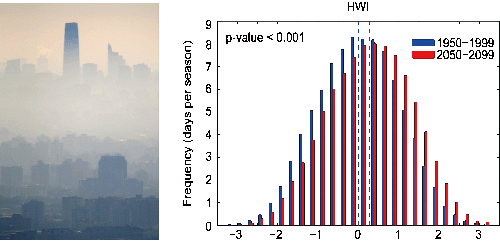
Frequency of Beijing winter severe haze has increased over past decades, culminating in events during January 2013, December 2015 and December 2016, when a high number of episodes occurred. In January 2013, for example, the maximum daily PM2.5 (fine particulate matter with a diameter of 2.5 µm or less) average near Beijing reached 500 μg m-3 (20 times concentration suggested by the WMO).
These suffering events lead to serious health concerns among the public, and a sharp decrease in visibility, causing massive disruption to economic activities. A new study published in Nature climate change, co-authored by Dr. LI Ke at the Institute of Atmospheric Physics, Chinese Academy of Sciences, projects a substantial increase in the frequency and persistence of conducive weather conditions to Beijing severe haze in response to climate change.

Left one shows atmospheric visibility dropped sharply during a severe haze event in Beijing; Right one shows an increase in the frequency of conducive weather conditions (represented by the HWI) under future high greenhouse emission scenario (RCP8.5)(2050-2099) relative to the historical climate (1950-1999). Special thanks to Prof. ZHU Jiang for providing the left photo which is featured as the cover of Nature climate change April 2017 issue. (Image by IAP)
“While the underlying cause of severe haze is increased pollutant emissions, local weather conditions play a part.” said LIAO Hong, a professor at Nanjing University of Information Science and Technology (NUIST), China, and the corresponding author of the paper.
Conducive weather conditions are an important ingredient of severe haze episodes, which feature reduced surface winter northerlies, weakened northwesterlies in the midtroposphere, and enhanced thermal stability of the lower atmosphere.
“Using observed long-term PM2.5 daily concentrations at Beijing and daily reanalysis meteorological fields, we developed an effective Haze Weather Index (HWI) to represent such conducive weather conditions.” said Dr. Wenju CAI, the first author of this study and a senior scientist at Commonwealth Scientific and Industrial Research Organisation (CSIRO), Australia.
After comparing the frequency of conducive weather conditions (represented by the HWI) between the historical (1950–1999) and future (2050–2099) climate in 15 models under Representative Concentration Pathway 8.5 (RCP8.5), the researchers project a 50% increase in the frequency of conducive weather conditions similar to those in January 2013, in response to climate change.
“The increased frequency of severe haze weathers is consistent with large-scale circulation changes, including an Arctic Oscillation upward trend, weakening East Asian winter monsoon, and faster warming in the lower troposphere”, explained Dr. CAI.
“While the priority to mitigate Beijing severe haze is to effectively reduce emissions of air pollutants, the global effort in reducing greenhouse gas emissions will contribute to decreasing the risk of Beijing winter severe haze events.” concluded Prof. LIAO.

86-10-68597521 (day)
86-10-68597289 (night)

52 Sanlihe Rd., Xicheng District,
Beijing, China (100864)

